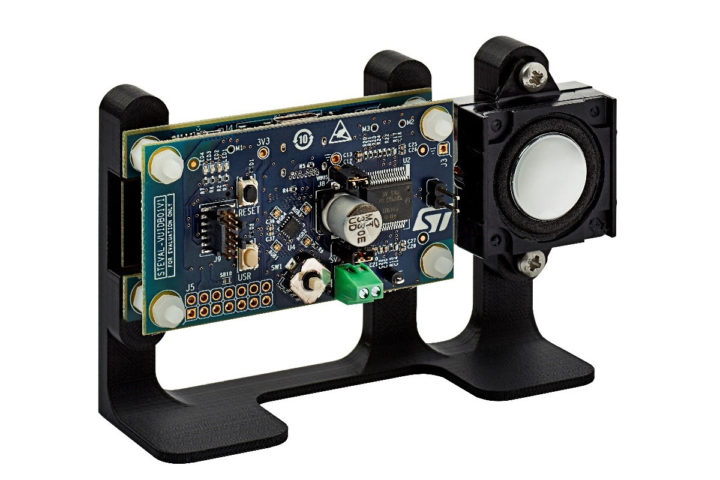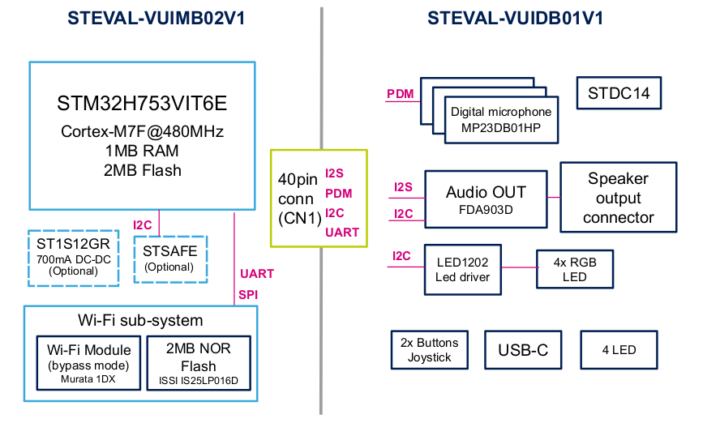We’ve already covered plenty of Amazon-qualified development kits working with Alexa Voice Services. But here’s another one with STEVAL-VOICE-UI evaluation kit making it to the list of Smart Home Dev Kits, which Amazon describes as “reference designs for creating smart home products such as light switches, thermostats, or Wi-Fi routers”.
STEVAL-VOICE-UI voice user interface (VUI) evaluation kit features an STMicro STM32H7 Arm Cortex-M7 microcontroller with 2 MB embedded flash, 1 MB embedded SRAM, 2.4 GHz Wi-Fi, and a microphone array with three MEMS microphones, as well as a loudspeaker, and some buttons and LEDs.

- Microcontroller – STMicro STM32H753VIT6E Cortex-M7 MCU @ up to 550 MHz with 2 MB flash, 1 MB SRAM
- Connectivity – 2.4 GHz Wi-Fi subsystem (Murata 1DX module) coupled to 2MB NOR flash (ISSI IS25LP016D)
- Audio
- 3x MP23DB01HP MEMS microphones with 36 and 30 mm spacing
- FDA903D class D digital input automotive audio amplifier
- 8 Ohm loudspeaker
- Misc – 4x RGB LEDs and 4x simple LEDs; joystick, reset, and user push-buttons
- Dimensions – 65×36 mm

The software package implements audio front-end, Amazon “Alexa” wake word, audio playback, and Amazon Alexa communication protocol software. The SDK runs on internal memories only for maximum integration. To get started with development, you’ll need a Windows OS (7, 8, and 10), Linux 64-bit, or MacOS computer to run IAR Embedded Workbench EWARM IDE, and a companion app is also available for Android 7+ or iOS 14+ mobile devices.

Jean-Luc started CNX Software in 2010 as a part-time endeavor, before quitting his job as a software engineering manager, and starting to write daily news, and reviews full time later in 2011.
Support CNX Software! Donate via cryptocurrencies, become a Patron on Patreon, or purchase goods on Amazon or Aliexpress





Once again I have no idea why would someone use STM32x7 for application that would benefit from more performance, or at least something containing a dedicated audio DSP. Can someone enlighten me on why STM32 became a default for almost anyone?
In that case, it’s made by STMicro, so they want to showcase the capabilities of their MCU. There are several audio interfaces in STM32H7 include multiple SAI, I2S, 12-bit DAC, and SPIDIF RX. Then I suppose the Cortex-M7 MCU @ 550 MHz is powerful enough to handle audio processing.
These are $15 chips. For $15 you can use quad core A53 with flash/DRAM and have $5 left over.
Not sure where you’d find those chips, the cheapest I could find on digikey is im8ul for $26 each and that’s without ram and flash. Also, developing Linux platforms are inherently much more expensive
You read CNX and you don’t know where to get them? Check out all of the Chinese SOC manufacturers like Allwinner, AMLogic, Rockchip, etc. Just search here for past articles.
Yeah.. not really sure.. probably cheaper, both production and development, using cm7 instead of learning to use a DSP. Probably, I think STMicro has the best sw modules.. many of them normally expensive, but free of use in stm32s.